The “RADE Loop”—a fusion of U.S. Air Force Colonel John Boyd’s “OODA Loop” and London Fire Brigade Crew Commander Paul Grimwood’s “Tactical Ventilation Strategy”—is a model that outlines the decision-making process and its contributing factors. Its core elements are as follows:
- Read the conditions,
- anticipate the progression,
- determine the needs, and
- execute the tactics.1-6
The RADE Loop is not a mnemonic to be recalled out in the field and used as a checklist or sequential action plan. Rather, it was constructed to demonstrate how fireground decisions are made, identifying the influential factors and the information that is processed (largely occurring subconsciously) as well as the relationship between these different facets. When we understand what is taking place and how all the pieces are connected, we can more accurately assess a situation, identify the available options, and consistently make better decisions rapidly.
Reading the Conditions
Although it technically begins on the receipt of the alarm, the physical process is not initiated until our arrival on scene. When pulling up to the fire building, immediately read the conditions. Start with observing the building; identify the construction, height, roof style/pitch, openings, and security measures. Also, evaluate the presentation of the smoke (volume, velocity, density, and color) and fire to determine its location and extent; doing so will aid in recognizing the inlets and outlets, identifying the existing points of ventilation as well as their current and potential pathways.7 Gauge the life hazard based on the dispatch information, the time of day, the occupancy type, and any reports from occupants or bystanders.
Next, assess the terrain to identify any obstructions or traits that could hinder operations such as long setbacks; graded lots (i.e., walk-out basements or cellars); overhead wires; and fences, gates, and walls. The weather, most notably the wind velocity, can also significantly affect the fireground.
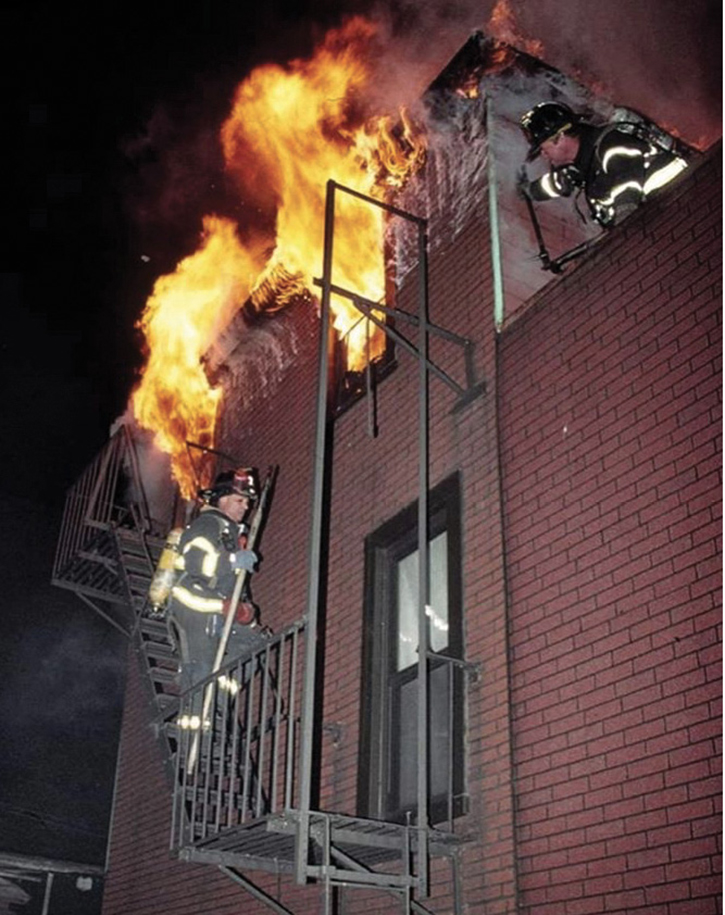
(1) The roof firefighter recons the conditions in the rear while the outside vent firefighter operates from the fire escape below. (Photos by Matt Daly.)
Anticipating the Progression
The information you glean from the incident will enhance your ability to predict how the fire will react so you can anticipate the progression of conditions. Forecasting the fire’s rate of growth, spread, and direction of travel as well as the layout and structural integrity of the building is imperative to calculating the operational window and formulating an action plan. Often called “BAG-ing” the fire, locate where it has been, where it is, and where it is going.8
Differentiate between the standard assumed life hazard vs. one that is known in addition to the last known location of any trapped victims; this will likely alter our tactical approach and the subsequent level of risk we are willing to take. This is also crucial in locating the most advantageous area of operation to aid in the confinement of the fire and protection of the exposures, to maximize the survivable space, and to locate and remove any trapped victims in the most effective and timely manner.
When observing the terrain and weather conditions, attempt to predict how the obstacles, hazards, and hindrances will impact the fire behavior and the firefighting operations including apparatus positioning, accessibility, maneuverability, and traction as well as the level and speed at which the crews become fatigued and need relief/rehabilitation.
Determining the Needs, Executing the Tactics
Fireground incident commanders (ICs) must account for and prioritize the operational demands of the incident and weigh the tactical options against the available resources. Once they determine the needs, they must identify how they can meet those objectives based on the present capabilities and the subsequent reflex time required to do so.
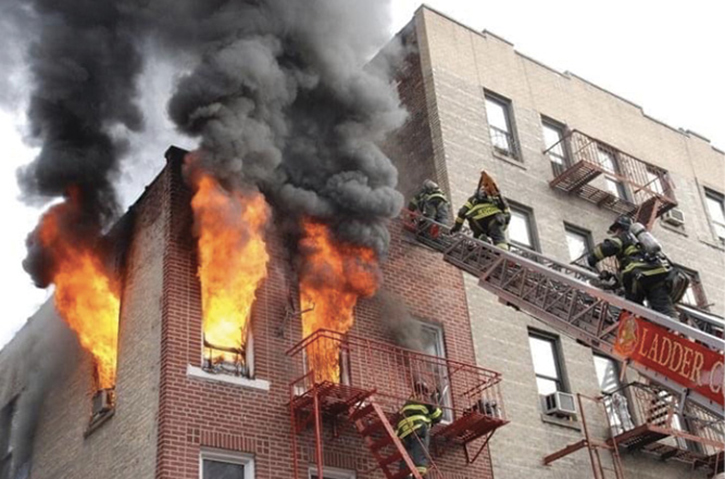
(2) The outside vent firefighter patiently waits on the fire escape to vent the top-floor window as roof firefighters ascend the aerial directly above.
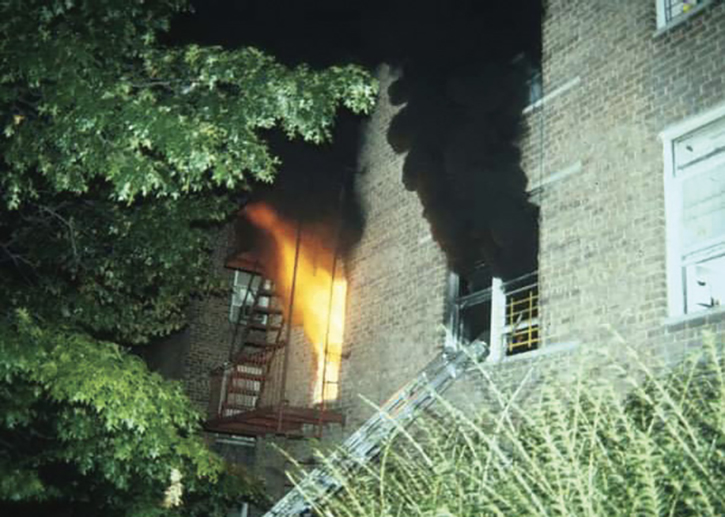
(3) Heavy fire and thick, black smoke vent from the windows, indicating advanced and rapidly deteriorating conditions.
Once ICs make these decisions, they must communicate the plan properly. Providing the “commander’s intent”—i.e., informing subordinates what is to be accomplished and for what purpose—is the key to ensuring the tactics are executed appropriately and the desired end state is achieved.1, 3, 9 However, the command structure should be decentralized to provide frontline crews with the authority to make tactical-level decisions to best mitigate the situation with which they are being confronted based on their firsthand knowledge of the conditions. Although operations should adhere to any established processes such as standard operating guidelines and unit/riding assignments and ensure everyone is operating off the same playbook, there must be latitude for discretion.
Operational doctrine should not be a formula but a roadmap for thinking that allows for decision making.2 Empower subordinates to take initiative if an advantageous opportunity arises, even if it means deviating from the script—as long as it is communicated and justified. Once an operation has been executed, gauge the impact to determine its effectiveness and if any further actions must be taken, which essentially restarts the RADE Loop in a continuous cycle.
Fireground Tempo
Accurately assessing the fire’s rate of change is imperative to establishing the correct operational tempo, defined as “speed relative to a problem set.” The purpose of our tactics is to positively influence the fire and the environment—to “make it behave”—so we can gain the upper hand. Fireground tempo is “a series of disciplined, appropriate, and timely tactical actions that promote mission accomplishment and enhance survivability … performed at a rate quicker than the environment’s [fire’s] rate of change.”11 Achieving an advantageous tempo requires the ability to rapidly extract and process information, from all forms of sensory input, but it is predominantly visual, auditory, and tactile. The more we understand the fireground and our tactics, the more efficient, accurate, and effective our size-up—as well as our intuitions—will be.5
Figure 1. The RADE Loop
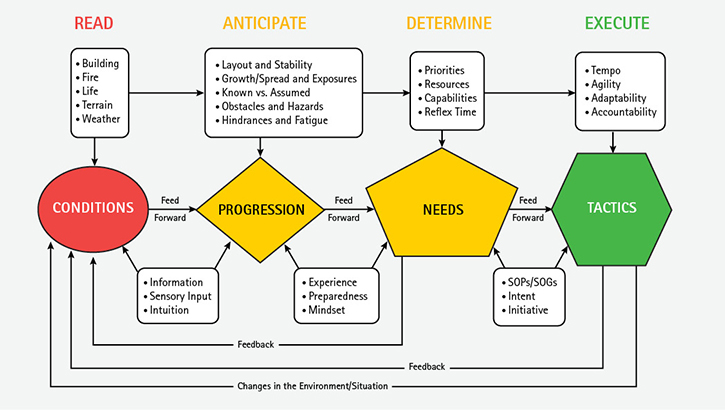
This model, which identifies the contributing factors and variables, outlines the continuous and dynamic nature of the decision-making process. (Figure courtesy of author.)
The ability to establish tempo (i.e., set the pace) is often determined by one’s level of situational awareness and intuitive decision-making ability, recognizing emerging cues and trends to address any threats and capitalize on opportunities. Intuition is the capacity to readily match these patterns to past events or previous knowledge stored in our memory.5, 10 Although this is largely developed through first-hand experience, it can be honed through realistic training and real-world reinforcement, with quality repetition being the common denominator. Performance, therefore, is a matter of our individual preparedness and mindset.1 Those operating at a high-level can anticipate the progression and determine the needs subconsciously.5, 11 Because of this rapid cognition, they can seemingly bypass those intermediate steps and devise an appropriate “action script,” immediately executing the tactics.5 In turn, the four elements of the RADE Loop are color coded in the same fashion as a traffic light, representing the need for stopping to observe, taking caution to analyze and decide, and going with the plan.
Speed is one of the primary drivers of establishing tempo and is critical to gaining what U.S. Navy Admiral William McRaven, commander of the Special Operations Command, refers to as relative superiority, “a decisive advantage over a larger or well-defended enemy.”12 Gauging how long it will take to get in position and complete an operation, based on our resources and capabilities—called reflex time—is critical in determining how the incident priorities can be most effectively and efficiently addressed. This requires that ICs and company officers be well aware of the strengths and weaknesses of their crews and equipment, understanding their limitations. Generating advantage is more than just about speed; it requires careful timing and execution at the pivotal moment. Developing a sense for the rate at which the conditions are changing, along with awareness of the crews’ progress, is essential to establishing the correct operational tempo and exploiting every potential opportunity that arises. Timing means knowing when to act and, equally important, when not to act.3
Establishing a superior pace goes beyond the initiation and completion of a single task; it is essential for the entire operation. Implementing the initial operations is often the easiest to achieve, in this regard, particularly from a command and control aspect. The first-arriving units, especially when strong operational systems are in place, go right to work, addressing the primary objectives. However, challenges arise when the incident is more complex or severe and these crews need immediate assistance or replacement. The speed with which they are able to make these transitions, called agility, is imperative to seizing and maintaining operational momentum.
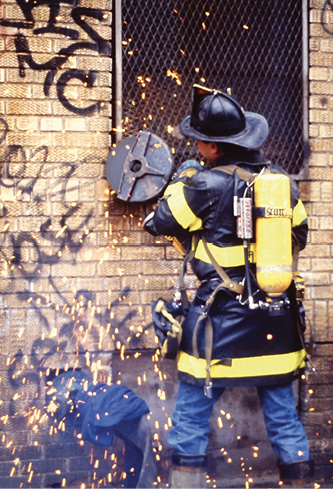
(4) Metal grates that are installed for added security will cause a delay in the ventilation of those windows and their ability to be used for access/egress.
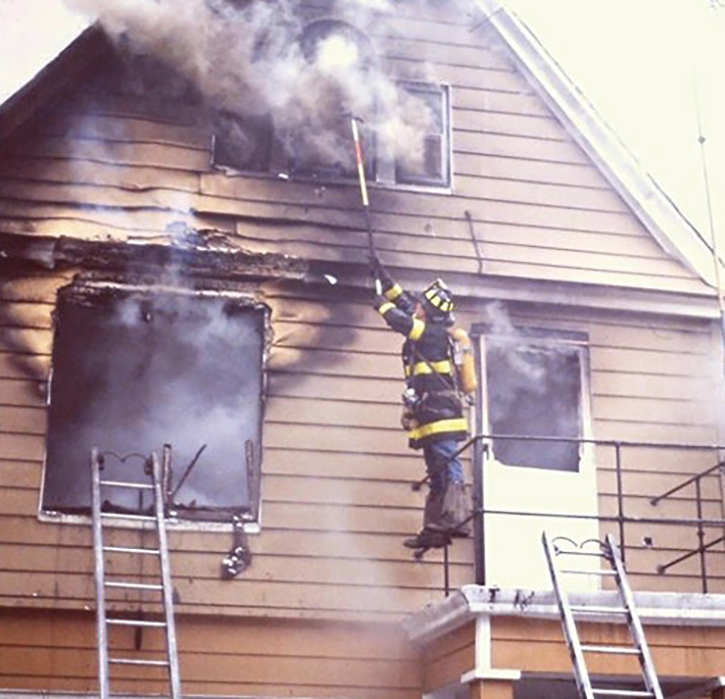
(5) The outside vent firefighter takes the gable window at the right time to relieve conditions in the attic for the engine company attacking the fire.
Along those same lines is the capacity to adjust to changes in the environment or situation at hand, known as adaptability. The rate at which we do so is directly proportionate to our capacity for anticipating and improvising as the fireground evolves.3 Even so, it is far more advantageous to shape the environment rather than adapt to it.4 By staying alert and maintaining optimum readiness, we can better recognize emerging signs and have the flexibility to take proactive measures to combat them.
Fireground Resources
ICs must ensure they have ample resources to mitigate the incident effectively and efficiently while also accounting for any likely contingencies. They must plan not only for they need now but also for what they may potentially need as the situation progresses. This is especially true during extreme weather situations, where crews will experience greater levels of fatigue and will need to be relieved at shorter intervals. Doing so requires establishing and maintaining a ready reserve until the incident is placed under control. By “stacking the deck,” there will be a surplus of personnel on standby to tap into at a moment’s notice. These assets can be mobilized at any point; immediately support or replace the initial units operating; and assist/back-fill the rapid intervention team if activated. For many agencies, this may require mutual- or automatic-aid agreements. This is not a sign of weakness but rather accepting reality and, more importantly, responsibility.
Unfortunately, the failure to implement these agreements and request additional resources is a fairly common occurrence for some organizations, and a failure to do so is becoming an even greater detriment in the wake of the continual trend of declining staffing levels. This issue is typically fueled by pride and ego, especially when it requires assistance. Sometimes, there may be apprehension of stripping the community of its remaining resources and not being adequately prepared in the event of a simultaneous incident. ICs must remember that the incident of which they are presently in charge is their sole priority, and they are ultimately responsible to ensure that it is mitigated appropriately. The last thing you want is to look in the street and have no one left when you need them the most. Like the old saying goes, “A bird in the hand is worth two in the bush.”
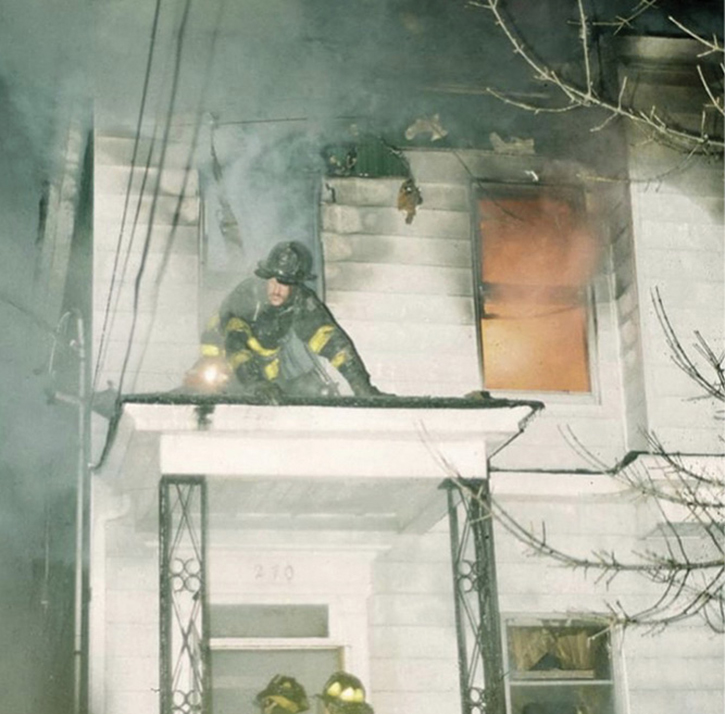
(6) A rescue firefighter moves out onto the porch roof as conditions begin to deteriorate. topside.
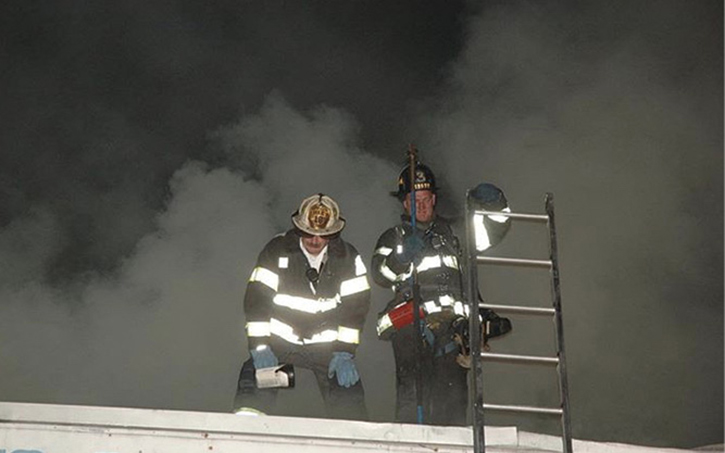
(7) The battalion chief assigned to the roof division communicates with the incident commander on the conditions and progress of crews working topside.
As we operate, we must ensure that we outmaneuver the fire, not each other. It is imperative that we understand the impact and limitations of our tactics and communicate, coordinate, and control our operations. We must also acknowledge and appreciate that tempo is itself a weapon, often the most important. Superior speed allows us to dictate the terms of combat and is necessary to concentrate superior strength at the decisive point.1 Doing so is achieved through disciplined and skillful operations and maintaining accountability at all levels.
Each incident we face will present its own unique set of variables, which must be specifically accounted for and addressed accordingly. The importance of an evolving size-up cannot be overstated. Being able to accurately and concisely evaluate the situation at hand and predict how it will progress is the very essence of situational awareness and the foundation of sound decision making. Fire Department of New York Deputy Chief (Ret.) Tom Neary said it best, “Size-up is what separates the good ones from the great ones.”
References
1. Gray, AM. (1989). FMFM-1: Warfighting. United States Marine Corps: Washington, D.C.
2. Grimwood, P. (2017). Euro Firefighter 2. D&M Heritage Press: West Yorkshire, UK.
3. Krulak, CC. (1997). MCDP 1-3: Tactics. United States Marine Corps: Washington, D.C.
4. Coram, R. (2002). Boyd: The Fighter Pilot Who Changed the Art of War. New York, NY: Back Bay Books.
5. Klein, G. (2003). The Power of Intuition: How to Use your Gut Feelings to Make Better Decisions at Work. Crown Publishing: New York, NY.
6. Klein, G. (1998). Sources of Power: How People Make Decisions. MIT Press: Cambridge, MA.
7. Fields, A. (2019). The Attacking Handline. The Nozzle Forward.
8. Willink, J and L Babin. (2016). Extreme Ownership: How Navy Seals Lead and Win. St. Martin’s Press: New York, NY.
9. Brezler, J and T Richardson. Fireground Tempo Lecture, April 22, 2017.
10. Gladwell, M. (2007). Blink: The Power of Thinking Without Thinking. Back Bay Books: Boston, MA.
11. McRaven, W. (2009). Spec Ops: Case Studies in Special Operations Warfare: Theory and Practice. Presidio Press: New York, NY.
12. Avillo, A. (April 2020). “Uncommitted Tactical Reserve Assignment: The RIT Assist Team.” Fire Engineering.
NICHOLAS PAPA is a 13-plus-year member of and a lieutenant with the New Britain (CT) Fire Department, where he is assigned to Engine Co. 1. Papa is also a UL-FSRI technical panelist for the Coordinated Fire Attack Study. He is the author of the upcoming book Coordinating Ventilation: Supporting Extinguishment & Survivability. Papa is a frequent contributor to Fire Engineering and has been an FDIC International classroom instructor since 2017.
MORE NICK PAPA
Training Minutes: Coordinated Ventilation
Overhaul Is Ventilation: Providing Air to Concealed Spaces
Tactical Ventilation: Bridging the Gap Between Research and Reality
Back-to-Basics Drilling for the Engine Company, Part 1 | Part 2

